Scale insects are very common pests of landscape trees and shrubs, yet are often overlooked when scouting. They can, however, be responsible for chlorosis, branch die-back or ultimately death of the plant. Scales are broadly categories as soft and armored scales. Soft scales produce soft, cottony, powdery or waxy substance that cannot be separated from the scale body. Common soft scales in Georgia are Indian wax scale, Florida wax scale, brown soft scale, oak lecanium scale, magnolia scale, cottony maple scale, cottony camellia scale, cottony cushion scale and azalea bark scale (Table 1). Armored scales have a hard shield-like cover that is not attached to the body of the insect. Examples of common armored scales in Georgia are tea scale, euonymus scale, obscure scale, false oleander scale, juniper scale and gloomy scale (Table 1).
Soft scales (lecanium, kermes, wax and bark scales) produce honeydew when they feed directly on plant parts that transport fluid and nutrients. This sugary liquid can attract ants and supports growth of the unsightly black sooty mold fungus. Most of the soft scales have one generation per year with few exceptions. Armored scales are generally flat in appearance, cryptic and well camouflaged. They do not produce honeydew and feed by bursting plant cells and feeding on the contents. They do not directly feed on the vascular bundles of the plant. The waste of armored scale is produced as protective hard cover. Except for adult males and crawlers, armored scales live inside their protective scale covering and previously molted skins. Soft scales secrete a wax covering, protecting them from natural enemies, pesticides and desiccation. Most of the armored scales have multiple generations per year.
Biology and lifecycle
Scale insects spend most of their lives immobile under their protective coverings. When eggs hatch, the mobile crawlers walk or are blown by the wind to new locations where they settle and begin to feed and produce their own protective coating. The mobile crawlers do not produce protective covering on the body. When the larvae molt, they add a layer of protective covering on the previous one. For some armored scales, the added layers increase in diameter as the larvae increase within the covering. Most scales undergo 3 to 4 larval stages. Many scales spend the winter on twigs and bark before crawlers move to new foliage in the spring. Some scales are strictly bark- dwellers and can be the most difficult to control.
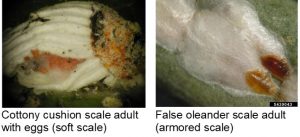
Scouting
Check the bark of plants and flip over bumps or lumps that could be scales. If there is a soft body underneath the scale cover, it is an armored scale. If the whole bump (scale body) comes up and can be squished, then it is probably a soft scale. If ants or wasps are attracted to foliage look for honey-dew producing scales (or aphids or mealybugs). Paper wasps can be attracted to honeydew, but also troll for caterpillars to feed their young.
The crawler stage is particularly vulnerable to control efforts and can be detected through close inspection. Consider placing double-sided sticky tape on branches with winter scale populations to detect crawlers hatching in the spring. Insects develop in direct relation to temperature, so scale hatch can be predicted. This combination of time and temperature or physiological time is referred to as Degree Day accumulation. Degree Day accumulation can be determined by checking the weather data available through the Georgia Automated Environmental Monitoring Weather Network https://weather.uga.edu. Common scale insects, their usual plant hosts and typical occurrence of first crawlers is given in Table 1. Use the information as a guide to schedule scouting activities for these pests.
Table 1. Major scale species attacking ornamental shrubs and trees in Georgia.
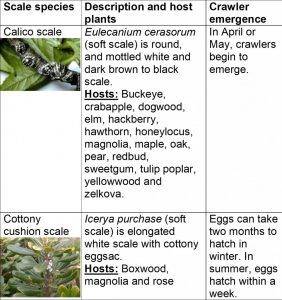
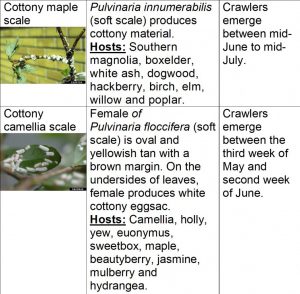
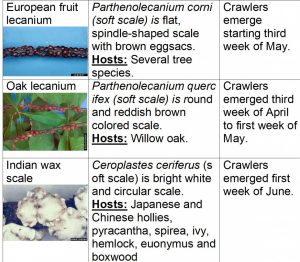
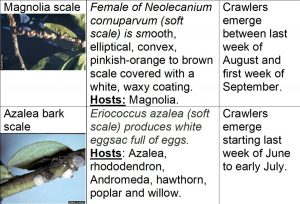
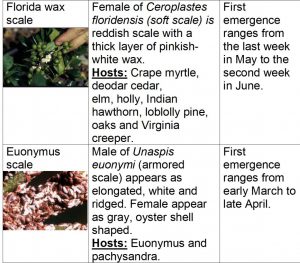
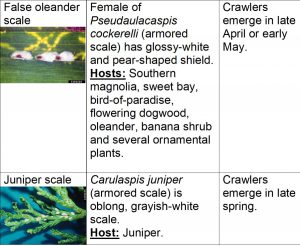
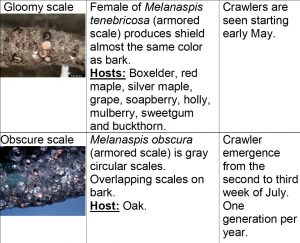
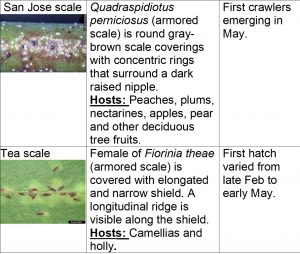
Management
Scale infestations primary occur when the host shrubs or trees are under stress. The types of stress can be from inadequate water (drought), poor fertility or elevated temperature (even increased by few degrees). Presence of impervious surfaces around the host trees or shrubs can increase the ambient temperature, which can increase fecundity of the scale females and rapid population growth. Early detection is key to successful management. Damage and infestation of scales can be specific to certain tree or plant species or their cultivars; thus, host plant or tree and their cultivar selection is important. If infestation is high on certain branches or twigs, pruning certain plant parts can help reduce infestation. Sometimes, pruning allows the influx of sunlight, which can improve scale control. The pruned branches or twigs should be immediately removed from infested area and destroyed to prevent re-infestation from the surviving scales.
Scales are primarily managed by natural biological control activity. Natural enemies play a critical role in keeping the scale population under low profile. The natural enemy complex include several species of lady beetles, predaceous mites and parasitic wasps. Both larvae and adults of lady beetle feed on scales. Young larvae of certain lady beetle species are smaller than others. They can access underneath the scale shield and feed on the developing scale. Several species of parasitic wasps naturally occur in the landscape and parasitize scales. Parasitic wasps lay eggs on the scales and the larvae feed on the scale. Adults of parasitic wasps are not parasitic. The parasitized scales are usually black colored and can be found flipping the scale shield or exit hole on the shield.
Insecticide use is necessary in some situations to reduce the scale population growth. There are some factors that need to be considered when using insecticides. First, identify the scale species and determine whether the infestation is from an armored or soft scale. Regardless of soft or armored scales, application of horticultural oil during winter can destroy the overwintering scales. Similarly, a delayed winter spray of oil before bud-break is effective in killing certain scales. In spring and summer, if it is feeding on the woody tissues (bark and twig) topical applications of oil or insect growth regulators (pyriproxyen or buprofezin) at least twice during each crawler emergence period can improve control. Other insecticides such as insecticidal soap and neonicotinoids (dinotefuran, acetamiprid, thiamethoxam, clothianidin) can also be used, especially on soft scales, but care should be taken to avoid impacts on natural enemies and other non-target organisms (e.g. bees). If scales are feeding on foliage, neonicotinoid insecticides applied via indirect methods work well especially for soft scales as do others applied topically at crawler emergence. Horticulture oils, insect growth regulators and neonicotinoid insecticides are considered reduced risk insecticides, as they are relatively safe to humans, reduced non-target toxic effects, and compatible to other integrated pest management approaches. Besides horticulture oils and insect growth regulators, other contact insecticides such as organophosphates (diamethoate, disulfoton), carbamates (carbaryl) and pyrethroids (deltamethrin, bifenthrin), are effective as foliar applications but they are also harmful to beneficial arthropods. Second, soft scales usually have one or two generations per year whereas, most of armored scales have multiple generations per year (three to four generations). Later in the year, these generations can overlap especially for armored scales. It is also important to note that crawler emergence timing vary by scale species as shown in Table 1. Thus, understanding the biology of the scale species to track crawler emergence timing to determine foliar insecticide application. If the systemic insecticide are used as soil drench or trunk injection, the timing of crawler emergence is less critical and a single application should provide adequate control. Multiple applications of insecticides may be required if insecticides are applied as foliar spray especially for armored scales. Third, location of scale infestation within a tree or shrub such as on foliage, stem, twigs or branches is an important factor if systemic insecticide is used. Typically, systemic insecticides move upward (from root system to foliage) and end up in actively growing leaves. Most of the soft scales tend to infest the foliage and thus, any neonicotinoid systemic insecticides are usually effective on those scales. However, armored scales typically infest on the twigs, branches or bark of the host tree or shrub. These scales are usually exposed to lower dose of systemic insecticide than those scales infest the foliage because systemic insecticides usually move through the vascular bundles (phloem or xylem vessels) and do not stay there. Also, most of the armored scales do not directly feed on the vascular bundles rather than on the cells underneath where they colonize. Thus, they are most likely not exposed to applied insecticide dose that can cause mortality. Among the neonicotinoid insecticides, dinotefuran is effective in reducing armored scales partly because of its high water solubility and mobility within the tree hosts. Finally, size of the host plant is an important factor to consider when using insecticide. Again, dinotefuran has shown efficacy against scales infested on canopies of large trees within a month after soil or trunk injection mostly because of its high water solubility and movement within the tree. In contrast, other neonicotinoids such as imidacloprid, thiamethoxam or clothianidin will require more than a month to show signs of efficacy because they have relatively lower water solubility and mobility within the tree than dinotefuran.
References
Frank, S. 2012. Reduced risk insecticides to control scale insects and protect natural enemies in the production and maintenance of urban landscape plants. 41: 377-386.
Dale, A.G., and S. D. Frank. 2014. The effects of urban warming on herbivore abundance and street tree condition. PLoS ONE 9: e102996. (doi:10.1371/journal.pone.0102996.
Dale, A. G., E. Youngsteadt, and S. D. Frank. 2016. Forecasting the effects of heat and pests on urban trees: impervious surface thresholds and the ’pace-to-plant’ technique. Arboric. Urban For. 42: 181-191.
Hodges, G. S., and S. K. Braman. 2004. Seasonal occurrence, phenological indicators and mortality factors affecting five scale insect species (Hemiptera: Diaspididae, Coccidae) in the urban landscape setting. J. Entomol. Sci. 39: 611–622.
Hubbard, J. L., and D. A. Potter. 2005. Life history and natural enemy associations of calico scale (Homoptera: Coccidae) in Kentucky. J. Econ. Entomol. 98: 1202–1212.
Kabashima, J. N., and S. H. Dreistadt. 2014. Scales: integrated pest management for home gardeners and landscape professionals. University of California, Agriculture and Natural Resources, Statewide Integrated Management Program, Pest Notes, Publication 7408, Davis, CA.
Robayo Camacho, E., and J. H. Chong. 2015. General biology and current management approaches of soft scale pests (Hemiptera: Coccidae). J. Integr. Pest. Manage. 6: 1–22.
Robayo Camacho, E., J. Chong, S. K. Braman, S. D. Frank and P. B. Schultz. 2017. Life History of Parthenolecanium spp. (Hemiptera: Coccidae) in Urban Landscapes of the Southeastern United States. 110: 1668–1675.